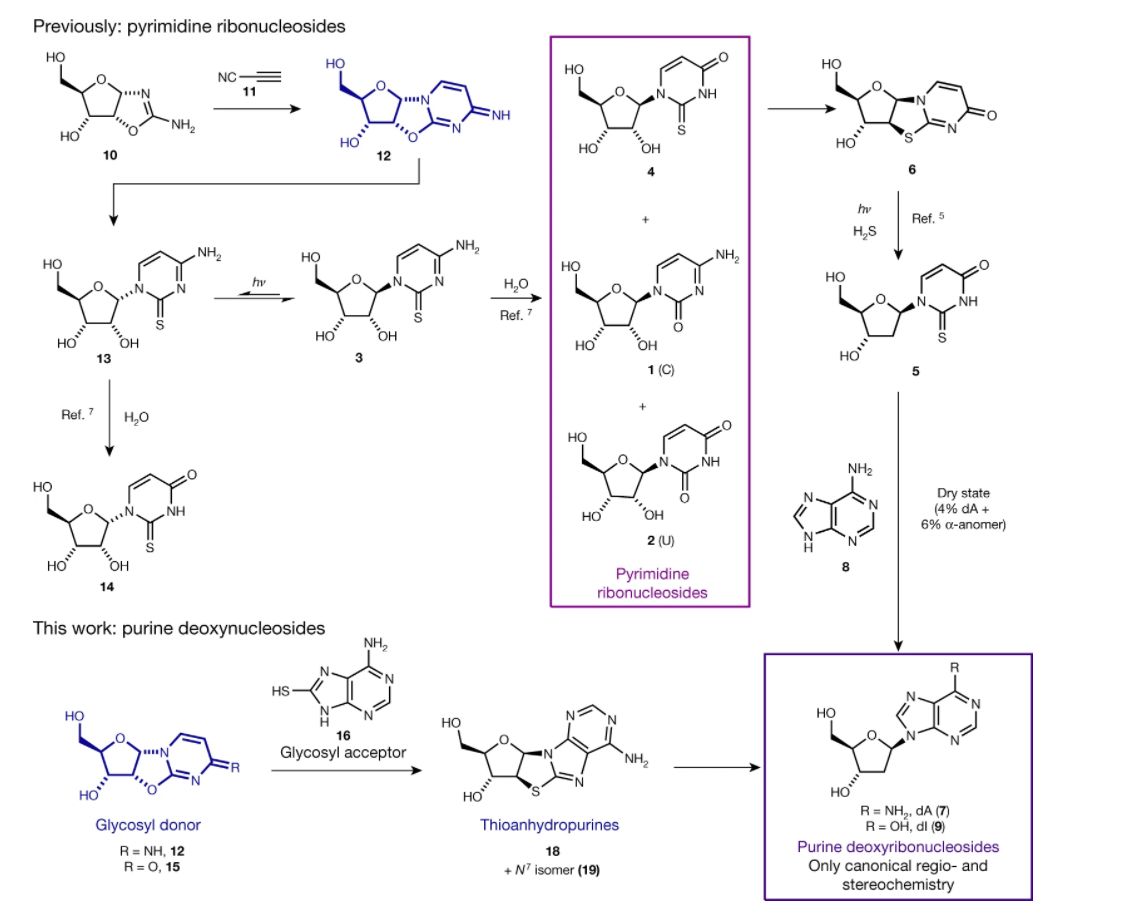YOUR BROWSER IS OUT-OF-DATE.
We have detected that you are using an outdated browser. Our service may not work properly for you. We recommend upgrading or switching to another browser.
Date: 18.08.2020 Category: general news, international cooperation
Professor Robert Góra, Mikołaj Janicki from the Faculty of Chemistry, and W3 graduate Rafał Szabla, PhD (currently the University of Edinburgh) took part in research conducted by an international group of scientists, whose results were published in the journal Nature at the beginning of June.
 The research carried out by the team led by Professor John Sutherland from the MRC Laboratory of Molecular Biology in Cambridge suggests that the building blocks of RNA and DNA information polymers were formed on Earth at the same time, and the first information polymer could have been their hybrid, which is a new important clue for researchers of early life.
The research carried out by the team led by Professor John Sutherland from the MRC Laboratory of Molecular Biology in Cambridge suggests that the building blocks of RNA and DNA information polymers were formed on Earth at the same time, and the first information polymer could have been their hybrid, which is a new important clue for researchers of early life.
Questions about the genesis of life on Earth have been asked by humanity since its very beginning. The same can be said about the history of the development of views on this matter formulated in the world of science.
– It would be difficult to summarise them, even if we focus only on the most popular ones – believes Professor Robert Góra from W3’s Department of Physical and Quantum Chemistry. – It should be stressed that the scientific community is far from consensus on this issue. However, the basic paradigm of life on Earth seems to be quite universal. All living organisms consist of one or many cells that store information about their structure and function in the form of a sequence of only four different molecules – the so-called nucleotides – from which the molecules of information polymers of DNA and RNA are made – explains our researcher.
 One of the biggest challenges in the field of research into the beginning of life in terms of chemistry (so-called prebiotic chemistry) turned out to be the synthesis of nucleotides in the conditions prevailing on Earth in the period which the oldest traces of living organisms’ presence come from, i.e. about 3.8 billion years ago. Nucleotide molecules consist of three subunits: a sugar (ribose or deoxyribose), a nucleic base (adenine, guanine, cytosine and uracil or thymine) and a phosphate residue.
One of the biggest challenges in the field of research into the beginning of life in terms of chemistry (so-called prebiotic chemistry) turned out to be the synthesis of nucleotides in the conditions prevailing on Earth in the period which the oldest traces of living organisms’ presence come from, i.e. about 3.8 billion years ago. Nucleotide molecules consist of three subunits: a sugar (ribose or deoxyribose), a nucleic base (adenine, guanine, cytosine and uracil or thymine) and a phosphate residue.
– This way of describing nucleotides seems obvious from the point of view of their structure and metabolic pathways in which they are formed in living organisms – says Prof. Robert Góra. – However, all attempts to synthesize nucleotides from these components, and in particular to create a glycosidic bond between the sugar and the base, without the complex cellular machinery have proven to be ineffective or too inefficient – adds the researcher from W3.
It was only in 2009 that a team led by Professor John Sutherland of Cambridge University described an efficient single- reaction synthesis pathway of two of the four RNA nucleotides, from the simple compounds available on the young Earth. In the synthesis, nucleotides are formed by a transitional product which already contains an embedded glycosidic bond, thus leaving aside the troublesome synthesis stage. The proposed pathway also explained the mystery of nucleotide synthesis despite the low availability of ribose.
In Professor Sutherland's original synthesis, what turned out to be extremely important was ultraviolet (UV) radiation, which initiated some of the reaction stages and purified the reaction mixture from unnecessary intermediate products. The necessity to carry out the reaction in the presence of UV radiation would explain the extraordinary photostability of the nucleotides and nucleic acid bases. The extremely interesting photochemistry of the reactions proposed by Professor Sutherland prompted the team from the Department of Physical and Quantum Chemistry, dealing with theoretical research into photochemical processes, to establish cooperation with the Cambridge team. It has proved fruitful that the researchers have already published three papers on their joint achievements in prestigious scientific journals: Chemical Science, Nature Chemistry and recently Nature.
 – As far as this research is concerned, our task was to explain the molecular mechanisms behind the photochemical processes applied by Professor Sutherland’s team – explains Prof. Robert Góra. – In the first two studies, it concerned unusual mechanisms of very efficient photoanomerisation, while in the last one the focus was on the highly selective photoreduction mechanism.
– As far as this research is concerned, our task was to explain the molecular mechanisms behind the photochemical processes applied by Professor Sutherland’s team – explains Prof. Robert Góra. – In the first two studies, it concerned unusual mechanisms of very efficient photoanomerisation, while in the last one the focus was on the highly selective photoreduction mechanism.
The Wrocław team, apart from Prof. Robert Góra, comprises Mikołaj Janicki, PhD student at the Faculty of Chemistry, and Rafał Szabla, PhD, W3 graduate, who is currently employed at the University of Edinburgh.
– It is with Doctor Rafał Szabla that we have been dealing with this subject from the very beginning, first as part of his engineer’s and master's thesis, which I supervised, and later, when I was a co-supervisor of his doctorate at the Institute of Biophysics in Brno – says Prof. Robert Góra. - Currently, we’re still closely cooperating, which resulted, among other things, in the said publication in Nature, which we think of as our joint success.
The development of Prof. Sutherland’s original synthesis by including reactive sulphur compounds allowed the simultaneous synthesis of two nucleotides of RNA: cytidine (C) and uridine (U) monophosphates and DNA: adenosine (A) and inosine (I), thus providing a complete nucleic acid alphabet, which could perform all vital functions. It is worth pointing out that inosine, which is the analogue of guanosine, also facilitates non-enzymatic copying of information polymers’ molecules.
– The key conclusion from these results is the suggestion that RNA and DNA nucleotides may have been formed at the same time of our planet's development, and the first information polymer may have been, in a way, their hybrid – summarises Prof. Robert Góra.
The authors of the publications also suggest that the separation of two polymers, the more stable DNA, currently used only for the storage of information, and RNA, which plays a key role in protein synthesis, was possible only at a later stage in the evolution of cellular organisms. – This is another step bringing us closer to understanding how life was created on Earth, and in the future, it may allow us to understand whether similar processes could take place in other planetary systems, too – explains Prof. Robert Góra.
The results of the research co-authored by our scientists have been widely commented on, in titles including Nature News & Views, New Scientist, Scientific American and Forbes.
Our site uses cookies. By continuing to browse the site you agree to our use of cookies in accordance with current browser settings. You can change at any time.